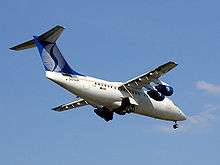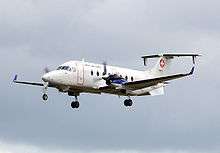T-tail




A T-tail is an empennage configuration in which the tailplane is mounted to the top of the fin. The arrangement looks like the capital letter T, hence the name. The T-tail differs from the standard configuration in which the tailplane is mounted to the fuselage at the base of the fin.
Advantages
The tailplane is kept well out of the disturbed airflow behind the wing and fuselage, giving smoother and faster airflow over the elevators. This configuration may give more predictable design characteristics and better pitch control; but in the case of an aircraft with a tractor propeller, pitch control is reduced because the T-tail takes the control surfaces outside the propeller slipstream. Responsive pitch control is crucial for aircraft flying at low speed, to allow effective rotation on landing.
This configuration also allows high performance aerodynamics and an excellent glide ratio as the empennage is less affected by wing and fuselage slipstream. A T-tail has a better effective aspect ratio (better lift slope), less interaction drag than a cruciform tail, and a more efficient vertical tail, the horizontal tail plate effectively increasing the aspect ratio of the fin by virtue of the 'end plate' effect[1], reducing turbulence and hence the induced drag of the fin. The rudder will also be more effective due to decreased induced drag. Therefore, the T-tail configuration is especially popular on gliders, where high performance is essential.
A T tailed aircraft is easier to recover from a spin than aircraft with other types of empennage, as the elevator is located above the rudder, thus creating no dead air zone ("burble") above the elevator where the rudder would be ineffective in spin conditions.[2]
Disadvantages
The aircraft may be prone to suffering a dangerous deep stall condition, where a stalled wing at high angles of attack may blank the airflow over the tailplane and elevators, thereby leading to loss of pitch control.[3] The American McDonnell F-101 Voodoo jet fighter suffered from this throughout its service life.
The vertical stabilizer must be made considerably stronger and stiffer (and therefore heavier) to support the forces generated by the tailplane.
The T-tail configuration can cause maintenance concerns. The control runs to the elevators are more complex, and elevator surfaces are much more difficult to casually inspect from the ground. The loss of Alaska Airlines Flight 261 was directly attributed to lax maintenance of the T-tail.
In order to mitigate some of these drawbacks, a compromise is also possible. The tailplane can be mounted part way up the fin rather than right at the top, known as a cruciform tail. The Sud Aviation Caravelle is an example of an aircraft with this configuration.
Adoption
The T-tail configuration is commonly used on regional airliners (carrying less than 100 passengers or so), from turboprop airliners such as the Pilatus PC-12, Beechcraft Super King Air, Bombardier Dash 8, and ATR 72, to regional jets such as the Embraer ERJ, Bombardier CRJ, and British Aerospace 146 families, up through medium-range jetliners such as the Boeing 727, McDonnell Douglas MD-80, and the Tupolev Tu-154. It is also common on business jets such as the Learjet and Gulfstream families.
The T-tail configuration is also found on several cargo aircraft such as the Ilyushin Il-76 and the Lockheed C-5 Galaxy. It is rarely seen in combat aircraft, although the Gloster Javelin, McDonnell F-101 Voodoo, and Lockheed F-104 Starfighter interceptors all sported T-tails.
See also
References
- ↑ Hoerner and Borst, Fluid Dynamic Lift, Directional Characteristics, T-tail page 13-11
- ↑ https://ntrs.nasa.gov/archive/nasa/casi.ntrs.nasa.gov/19720005341.pdf
- ↑ "Gloster Javelin - History". Thunder & Lightnings.
Further reading
- "T-tails and top technology". Flight International. 13 Oct 1979.
_d.jpg)
